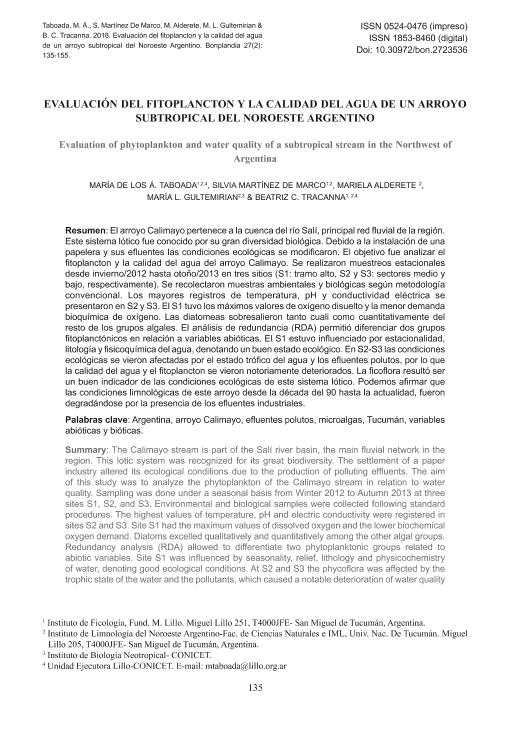Artículo
El arroyo Calimayo pertenece a la cuenca del río Salí, principal red fluvial de la región. Este sistema lótico fue conocido por su gran diversidad biológica. Debido a la instalación de una papelera y sus efluentes las condiciones ecológicas se modificaron. El objetivo fue analizar el fitoplancton y la calidad del agua del arroyo Calimayo. Se realizaron muestreos estacionales desde invierno/2012 hasta otoño/2013 en tres sitios (S1: tramo alto, S2 y S3: sectores medio y bajo, respectivamente). Se recolectaron muestras ambientales y biológicas según metodología convencional. Los mayores registros de temperatura, pH y conductividad eléctrica se presentaron en S2 y S3. El S1 tuvo los máximos valores de oxígeno disuelto y la menor demanda bioquímica de oxígeno. Las diatomeas sobresalieron tanto cuali como cuantitativamente del resto de los grupos algales. El análisis de redundancia (RDA) permitió diferenciar dos gruposfitoplanctónicos en relación a variables abióticas. El S1 estuvo influenciado por estacionalidad, litología y fisicoquímica del agua, denotando un buen estado ecológico. En S2-S3 las condiciones ecológicas se vieron afectadas por el estado trófico del agua y los efluentes polutos, por lo que la calidad del agua y el fitoplancton se vieron notoriamente deteriorados. La ficoflora resultó ser un buen indicador de las condiciones ecológicas de este sistema lótico. Podemos afirmar que las condiciones limnológicas de este arroyo desde la década del 90 hasta la actualidad, fueron degradándose por la presencia de los efluentes industriales. The Calimayo stream is part of the Salí river basin, the main fluvial network in the region. This lotic system was recognized for its great biodiversity. The settlement of a paper industry altered its ecological conditions due to the production of polluting effluents. The aim of this study was to analyze the phytoplankton of the Calimayo stream in relation to water quality. Sampling was done under a seasonal basis from Winter 2012 to Autumn 2013 at three sites S1, S2, and S3. Environmental and biological samples were collected following standard procedures. The highest values of temperature, pH and electric conductivity were registered in sites S2 and S3. Site S1 had the maximum values of dissolved oxygen and the lower biochemical oxygen demand. Diatoms excelled qualitatively and quantitatively among the other algal groups. Redundancy analysis (RDA) allowed to differentiate two phytoplanktonic groups related to abiotic variables. Site S1 was influenced by seasonality, relief, lithology and physicochemistry of water, denoting good ecological conditions. At S2 and S3 the phycoflora was affected by the trophic state of the water and the pollutants, which caused a notable deterioration of water quality and phytoplankton. Phytoplankton resulted to be a good indicator of the ecological conditions of this lotic system. We can affirm that the limnological conditions of the Calimayo stream from the 90s to the present have been degraded to the presence of industrial effluents.
Evaluación del fitoplancton y la calidad del agua de un arroyo subtropical del Noroeste Argentino
Título:
Evaluation of phytoplankton and water quality of a subtropical stream in the Northwest of Argentina
Taboada, María de Los Ángeles ; Martinez de Marco, Silvia; Alderete, Mariela del Carmen
; Martinez de Marco, Silvia; Alderete, Mariela del Carmen ; Gultemirian, Maria de Lourdes
; Gultemirian, Maria de Lourdes ; Tracanna, Beatriz Concepcion
; Tracanna, Beatriz Concepcion
 ; Martinez de Marco, Silvia; Alderete, Mariela del Carmen
; Martinez de Marco, Silvia; Alderete, Mariela del Carmen ; Gultemirian, Maria de Lourdes
; Gultemirian, Maria de Lourdes ; Tracanna, Beatriz Concepcion
; Tracanna, Beatriz Concepcion
Fecha de publicación:
11/2018
Editorial:
Instituto de Botánica del Nordeste
Revista:
Bonplandia
ISSN:
0524-0476
e-ISSN:
1853-8460
Idioma:
Español
Tipo de recurso:
Artículo publicado
Clasificación temática:
Resumen
Archivos asociados
Licencia
Identificadores
Colecciones
Articulos(IBN)
Articulos de INSTITUTO DE BIODIVERSIDAD NEOTROPICAL
Articulos de INSTITUTO DE BIODIVERSIDAD NEOTROPICAL
Citación
Taboada, María de Los Ángeles; Martinez de Marco, Silvia; Alderete, Mariela del Carmen; Gultemirian, Maria de Lourdes; Tracanna, Beatriz Concepcion; Evaluación del fitoplancton y la calidad del agua de un arroyo subtropical del Noroeste Argentino; Instituto de Botánica del Nordeste; Bonplandia; 27; 2; 11-2018; 135-155
Compartir
Altmétricas



